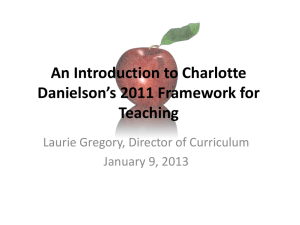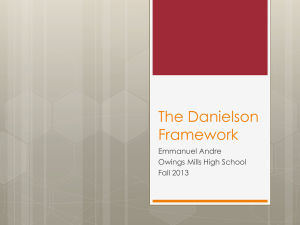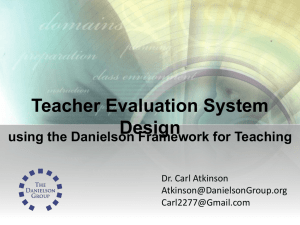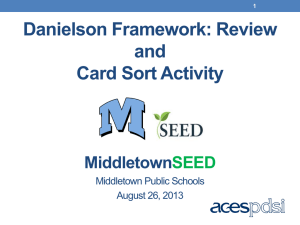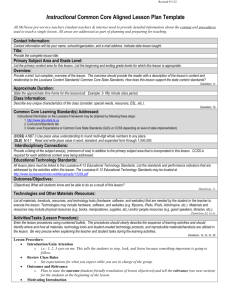CTE Danielson PPT - CTE Technical Assistance Center of NY
advertisement
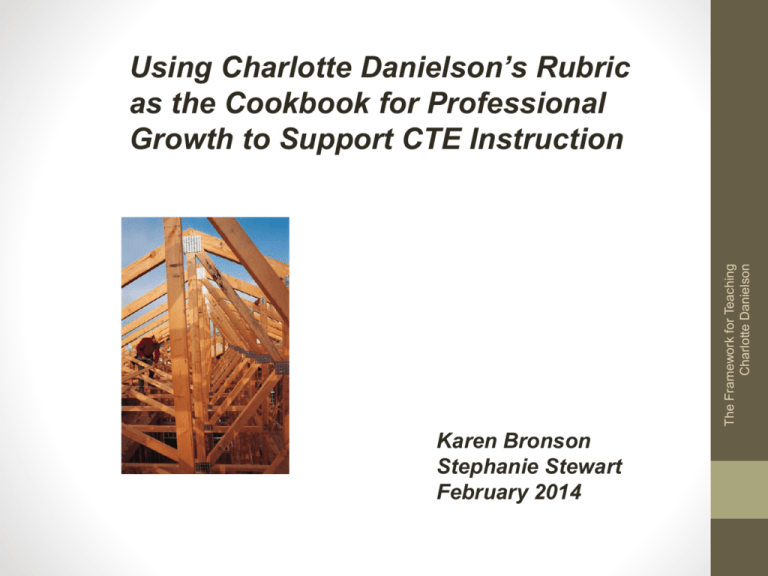
The Framework for Teaching Charlotte Danielson Using Charlotte Danielson’s Rubric as the Cookbook for Professional Growth to Support CTE Instruction Karen Bronson Stephanie Stewart February 2014 • All attendees are on mute during the webinar. • The presentation will be approximately 45 minutes, with 15 minutes for Q&A after the presentation • To ask a question to be addressed during the Q&A, type it into the questions pane on your control panel. Questions will be answered in the order they are received. • All questions are logged, and will be addressed by email after the webinar if they cannot be addressed live. • If you are disconnected and cannot reconnect independently please call (518) 723-2137 The webinar is being recorded and will be placed on the CTE TAC Website @ nyctecenter.org within 72 hours. From there you will be able to access the PowerPoint slide show as well as the recorded webinar. If you have questions or suggestions regarding upcoming webinars please contact the CTE Technical Assistance Center @ CTETAC@Spnet.us Enjoy the webinar! The Complexity of Teaching “After 30 years of doing such work, I have concluded that classroom teaching… is perhaps the most complex, most challenging, and most demanding, subtle, nuanced, and frightening activity that our species has ever invented.... The only time a physician could possibly encounter a situation of comparable complexity would be in the emergency room of a hospital during or after a natural disaster” Lee Shulman, The Wisdom of Practice, 2004 4 • What are the benefits of using a high quality rubric or framework to evaluate performance? What is your experience with observation or evaluation processes that do not use such a framework? The Framework for Teaching Charlotte Danielson Question: Benefits of Any Framework for Teaching •Development of shared understandings •Self-assessment and reflection on practice •Structured professional conversation The Framework for Teaching Charlotte Danielson •Common language A process, not an event … • Post observation conference for all observations, announced or unannounced • Opportunities for meaningful professional conversations and reflection The Framework for Teaching Charlotte Danielson • Pre-observation conference for announced observation The Evaluation System Two purposes: • Quality Assurance • Professional Learning Teacher Evaluation to Enhance Professional Practice, Danielson and McGreal, ASCD, 2000 8 ... for professional growth … the recipes and ingredients for excellent instruction … The Framework for Teaching Charlotte Danielson The Cookbook … Framework Overview •Four Domains •Twenty two Components •Seventy Six Elements •Four Levels of Proficiency The Four Domains: Domain 1: Planning and Preparation Domain 2: The Classroom Environment Domain 3: Instruction Domain 4: Professional Responsibilities A Framework for Teaching: Components of Professional Practice Domain 1: Planning and Preparation a. Demonstrating knowledge of content and pedagogy b. Demonstrating knowledge of students c. Setting instructional outcomes d. Demonstrating knowledge of resources e. Designing coherent instruction f. Designing student assessments Domain 2: The Classroom Environment a. Creating an environment of respect and rapport b. Establishing a culture for learning c. Managing classroom procedures d. Managing student behavior e. Organizing physical space Domain 4: Professional Responsibilities a. Reflecting on teaching b. Maintaining accurate records c. Communicating with families d. Participating in a professional Community e. Growing and developing professionally f. Demonstrating professionalism Domain 3: Instruction a. Communicating with students b. Using questioning and discussion techniques c. Engaging students in learning d. Using assessment in instruction e. Demonstrating flexibility and responsiveness 12 Danielson 2007 • Focus on LEARNING • COGNITIVE ENGAGEMENT • EVIDENCE Based • More STUDENT CENTERED; less teacher directed • Ongoing ASSESSMENT essential • VALIDATION of offstage planning and professional responsibilities The Framwork for Teaching Charlotte Danielson The Big Ideas: Performance Levels Four Levels of Effectiveness: Ineffective (Unsatisfactory) Developing (Basic) Effective (Proficient) Highly Effective (Distinguished) A word from Charlotte… “Everyone likes to visit Distinguished, but nobody lives there…” Domain 2:The Classroom Environment 2a: Creating an Environment of Respect and Rapport Figure 4.2b DOMAIN 2: THE CLASSROOM ENVIRONMENT COMPONENT 2A: CREATING AN ENVIRONMENT OF RESPECT AND RAPPORT Elements: Teacher interaction with students Student interaction with one another L E V E L O F P ELEMENT UNSATISFACTORY BASIC Teacher Interaction with Students Teacher interaction with at least some students is negative, demeaning, sarcastic, or inappropriate to the age or culture of the students. Students exhibit disrespect for the teacher. Student Interactions with one another Student interactions are characterized by conflict, sarcasm, or put-downs. Teacher-student interactions are generally appropriate but may reflect occasional inconsistencies, favoritism, or disregard for students’ cultures. Students exhibit only minimal respect for the teacher. Students do not demonstrate disrespect for one another. E R F O R M A N C E PROFICIENT Teacher-student interactions are friendly and demonstrate general caring and respect. Such interactions are appropriate to the age and cultures of the students. Students exhibit respect for the teacher. Student interactions are generally polite and respectful. DISTINGUISHED Teacher’s interactions with students reflect genuine respect and caring, for individuals as well as groups of students. Students appear to trust the teacher with sensitive information. Students demonstrate genuine caring for one another and monitor one another’s treatment of peers, correcting classmates respectfully when needed. Performance Levels: Key Words Teacher-directed success! Student-directed success! Unsatisfactor y Basic Proficient Distinguished Unsafe Lack of Unaware Harmful Unclear Poor Unsuitable None Partial Generally Inconsistently Attempts Awareness Moderate Minimal Some Consistent Frequent Successful Appropriate Clear Positive Smooth Most Seamless Solid Subtle Skillful Preventative Leadership STUDENTS Always 17 Levels of cognition and constructivist learning increase • Observation • Pre Observation – use mapping to identify what will be taught • Post observation – use mapping to determine at what level performance was reached • Examination of Artifacts • Essential for Domains 1 and 4 • Curriculum mapping contains resources as a component The Framework for Teaching Charlotte Danielson Sources of Evidence for Teaching • Locally Developed Assessments • SLOs (Student Learning Objectives) • Student Performance in CTE Program • Employability Profile The Framework for Teaching Charlotte Danielson Evidence of Student Learning Domain 1: You are the Designer “An essential act of our profession is to design curriculum and learning experiences to meet specified purposes. We are also designers of assessments to diagnose student needs to guide our teaching and to enable us, our students, and others to determine whether our goals have been achieved.” --Wiggins and McTighe Domain 1: Planning and Preparation a. Demonstrating knowledge of content and pedagogy a. Demonstrating knowledge of students b.Setting instructional outcomes c. Demonstrating knowledge of resources d.Designing coherent instruction e. Designing student assessments Domain 1 Examples: • Lesson and unit plans • Evidence of familiarity with IEPs and other student support documentation • Evidence of collaboration with student support personnel • Evidence of knowing students as individuals • Evidence of understanding of developmental differences • Use of varied resources in lesson plans, units and classroom visitations • Evidence of a range of formative and summative assessments that are focused on students learning • Evidence of varied activities to enhance learning • Use of curriculum mapping and other planning strategies CTE curriculum mapping • Curriculum mapping is key in connecting to the Danielson professional development rubric • The rubric is grounded in evidence • Curriculum mapping is grounded in documenting evidence • CTE programs and curricula are student centered, as is the Danielson rubric CTE Curriculum Mapping as a tool for using Danielson’s model of Professional Development • technique for exploring what is taught, how instruction occurs and when instruction is delivered. • process for collecting data that identifies the core content, the processes and the assessments used in the curriculum. • Evidence of student learning can be chronicled • Evidence of student learning can be cross-walked with the Danielson rubric and with elements of the curriculum mapping components. Domain 2: You are the Architect …working with your students to build and maintain a safe, respectful and invigorating environment for learning! Domain 2: The Classroom Environment a. Creating an environment of respect and rapport b. Establishing a culture for learning c. Managing classroom procedures d. Managing student behavior e. Organizing physical space • • • • • • • • • • • Teacher greets students by name as they enter the classroom. Students say “Shhh” when others talk during a classmate’s presentation. Students roll their eyes at a classmate’s idea. Teacher does not respond. The quality of teacher-student interaction is uneven, with occasional disrespect. Teacher demonstrates knowledge and caring about students’ lives beyond school. Teacher responds to disrespectful behavior among students. Students wait for classmates to finish speaking before beginning to talk. Teacher says, “Don’t talk that way to your classmates,” and the insults stop. The teacher does not call students by name. A few students do not engage with other classmates, even when in small groups. There is no disrespectful behavior among students. The Framework for Teaching Charlotte Danielson Some 2a Evidence Statements: Domain 2 Examples Domain 2: The Classroom Environment • 2c: Managing Classroom Procedures • Management of Instructional Groups • Management of Transitions • Management of Materials and Supplies • 2e: Organizing Physical Space • Safety and Accessibility • Arrangement of furniture and use of physical resources Let’s look at some real world examples of these components from CTE teachers! CTE Examples 2c: Managing Classroom Procedures Proficient Performance is described this way: • “There is little loss of instructional time due to effective classroom routines and procedures. With minimal guidance, students follow established classroom routines.” Distinguished Performance is described this way: • “Instructional time is maximized due to efficient classroom routines and procedures. Students contribute to the management of groups, transitions, and/or the handling of materials and supplies.” 2c Examples from CTE teachers: • Daily and weekly agendas on white board (Culinary) • Each week a student is appointed “lead” and is in charge of directing groups and managing distribution of supplies (Child Development) • Students pick index cards which direct them to randomly assigned groups, so that they are working with different classmates on a regular basis. (Economics) • I create competitive work crews and rotate foreman to understand different pressures of various roles (Landscape) • Seniors help and redirect juniors with class procedures and demonstrate safe use and storage of power tools (Telecom) • There is designated spot in the room for the day’s handouts and supplies for students to pick up on the way in (Health) CTE Examples 2e: Organizing Physical Space Proficient Performance is described this way: • “The classroom is safe, and learning is accessible to all students. The physical arrangement is appropriate to the learning activities. Teacher makes effective use of physical resources, including computer technology.” Distinguished Performance is described this way: • “The classroom is safe, and learning is accessible to all students. The physical arrangement is appropriate to the learning activities. Students contribute to the use or adaptation of the physical environment to advance learning.” 2e Examples from CTE Teachers: • A ‘classroom tour’ and scavenger hunt at the beginning of the course to learn where materials are stored (Childhood Dev) • For a crime scene investigation lab, four scene stations are set up in four corners of the room, with chairs for each small group arranged around the materials so students can think through their process beforehand and process their findings with minimal distractions from other teams (Forensics) • We practice transitioning from straight rows for direct instruction, to oval or U shape for discussion, and to small clusters for group work so that students can move desks within the period of instruction to create seating arrangements that support the goals of the activity.. (Graphics) Domain 3: You are the Teacher “Domain 3 is the heart of the framework for teaching; it describes the critical interactive work that teachers undertake when they bring complex content to life for their students.” -Charlotte Danielson Domain 3: Instruction a. Communicating with students b.Using questioning and discussion techniques c. Engaging students in learning d.Using assessment in instruction e. Demonstrating flexibility and responsiveness Domain 3 Examples Domain 3: Instruction • 3b: Using Questioning and Discussion Techniques • Quality of Questions • Discussion Techniques • Student Participation (Use the DOK Chart to create two Level Four questions) • 3c: Engaging Students in Learning • Activities and Assignments • Grouping of Students • Instructional Materials and Resources • 3d: Using Assessment in Instruction • Monitoring Student Learning Let’s learn more about questioning and assessment strategies and then consider some examples from CTE teachers … Two Kinds of Assessment: FORMATIVE ASSESSMENT SUMMATIVE ASSESSMENT • Happens during teaching • Happens after teaching • Focus is on assessment FOR learning • Focus is on assessment OF learning • Purpose is to know whether they are getting it, and therefore whether YOU need to adjust your instruction strategies • Purpose is to evaluate student performance to make decisions about grades, course completion, graduation, etc. The four big questions … For Formative Assessment: • • • • What are students supposed to be learning? How do I know if they are learning it? What am I going to do differently if they are not? What am I going to do to differentiate for students who are all over it and need additional challenge? What makes a quality assessment? • VALIDITY: Does it assess what I want it to assess? If I want a student to know how to build a bridge, do I give her a multiple choice test? • RIGOR: Is it aligned to standards? Are tasks designed to make kids think? Are items sufficiently challenging? • RELIABILITY: If the test is given at different times and scored by different teachers, is there consistency? Are rubrics anchored with examples/exemplars? • FAIR and UNBIASED? Are directions clear? Language and references accessible to all students? Webb’s DOK Chart Four levels of questions: • Recall • Skill/Concept • Strategic Thinking • Extended Thinking • Look at the Webbs DOK Chart and Examples of Level 1, 2, 3, 4 Assignments. How could these work in your classroom with your students? Webb’s DOK Video http://vimeo.com/42788913 Webb’s DOK Question Stems: DOK 1: Recall • When did _ happen? Who was responsible for the event? • What is the formula for _? DOK 2: Skill/Concept • How are _ and _ similar? Different? • How would you classify _? DOK 3: Strategic Thinking • Can you predict the outcome of _? • What conclusion can you draw from these three texts? • How would you test _ for _? DOK 4: Extended Thinking • Develop a thesis, drawing conclusions from multiple sources. • Determine alternative explanations for the result of an experiment. CTE Examples 3b: Using questioning prompts and discussion: Proficient Performance is described this way: • “The teacher poses questions to promote student thinking and understanding. Teacher creates a genuine discussion, providing adequate time to respond … and successfully engages most students in the discussion.” Distinguished Performance is described this way: • “The teacher uses a variety of questions to challenge students cognitively, advance high level thinking and promote metacognition. Students formulate questions, initiate topics and make unsolicited contributions.” 3b Examples from CTE Teachers • Structure questions that make students use information to solve a new problem. Example: After students have learned the minimum internal temperature for various meats, ask them what the internal temperature should be for a meat loaf recipe that uses three different meats: beef, pork and veal (Culinary Arts) • “Compare the swatch colored with 4N and 20 volume to the swatch colored with 4N and 40 volume developer. Which is closer to the desired outcome and why?” (Cosmetology) • “How can we measure the muzzle speed of a launcher? How can we apply this information to choose the correct angle so that the launched ball will land in a cup at a specific distance?” (Physics) CTE Examples 3c: Engaging students in learning Proficient Performance is described this way: “The learning tasks and activities are aligned with the instructional outcomes and are designed to challenge student thinking, resulting in active intellectual engagement by most students.” Distinguished Performance is described this way: “Virtually all students are intellectually engaged in challenging content through well designed learning tasks and suitable scaffolding by the teacher. There is evidence of some student initiation of inquiry and student contributions to the exploration of important content.” 3c Examples from CTE Teachers • Ask students to link instruction to recent animation example or to compare their animation project to a classic animation film, cartoon or character (Motion Graphics) • Students prepare a presentation in which they relate similarities and differences between artist Janet Fish’s glassware paintings and their artistic composition (Advertising Art and Digital Design) • Students role play a conversation between the supervisor and care provider in a nursing home over a safety issue that occurred (CNA) • Over the course of a year, students develop capstone activity which is year end fashion show (Fashion Design) CTE Examples 3d: Using assessment in instruction Proficient Performance is described this way: “Assessment is used regularly during instruction, resulting in accurate and specific feedback that advances learning. Students appear to be aware of the assessment criteria and some of them engage in self-assessment.” Distinguished Performance is described this way: “Assessment is fully integrated into assessment, through extensive use of formative assessment. There is some evidence students have contributed to the assessment criteria. A variety of feedback, from both teacher and peers, is accurate, specific and advances learning.” 3d Examples from CTE Teachers • Students must design a felling plan for a tree using HOPE (Hazards Obstacle Plan or Procedure Equipment). Students then assess and critique the felling plans of other crews. (Forestry) • “Twitter” as exit slip: student has index card and may use 140 characters to ‘tweet’ response to exit question which assesses understanding of the core content of the lesson (Auto Mechanics) • Students use the ‘belly button test’ to determine whether dough is done as a way of demonstrating understanding of the development of gluten when preparing bread dough. (Culinary Arts; Baking) Domain 4: You are the Professional Domain 4: Professional Responsibilities a.Maintaining accurate records b.Communicating with families c.Participating in a professional Community d.Growing and developing professionally e.Demonstrating professionalism Domain 4 Examples • Examples of accurate records; attendance, monitoring student progress • Examples of student completion of assignments • Examples of parent communication • Examples of participation in or leadership of school or district activities or initiatives • Examples of professional development and ways that professional learning was shared with colleagues • Examples of collaborative actions with colleagues for the purpose of increased student learning and achievement • Examples of reflective communication focused upon professional growth Think of examples .. • Work with a partner. Use the sheet provided to think of real examples of proficient or distinguished performance with regard to • • • • • Instructional Groups Transitions from one activity to the next Distribution and use of materials and supplies Safety and accessibility How classroom furniture and physical resources are arranged in the room for maximum learning • Give specific examples of how we could see proficient or distinguished examples of these components in your classroom Ex: In my cosmetology class, students are assigned rotating roles to distribute and collect materials such as hair color charts and smocks. Scissors are numbered and collected at the end of each class period to ensure safety. • In addition to formal teacher evaluation, how else can the Framework be used as a tool in professional practice? The Framework for Teaching Charlotte Danielson Question: The key: • see the process as an opportunity to learn and to see the rubric as the cookbook and recipes for your own professional growth. Take responsibility in the process to feel more ownership. Write an ‘elevator speech’ describing the Charlotte Danielson Framework for Teaching ? In 60 seconds or less, summarize the structure and priorities of the Danielson Framework for Teaching. Good luck! The Framework for Teaching Charlotte Danielson Can you…….? If you have questions or suggestions regarding upcoming webinars please contact the CTE Technical Assistance Center @ CTETAC@Spnet.us This webinar will be available for viewing at NYCTECENTER.ORG within 72 hours
